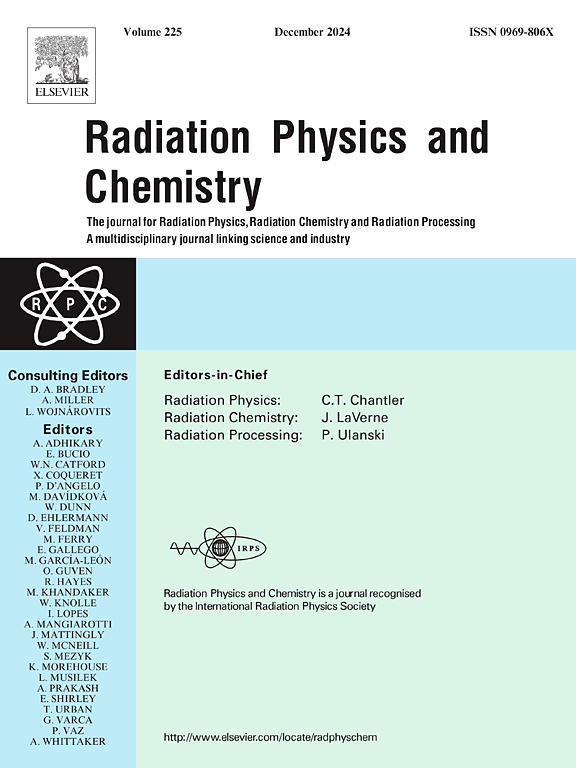Novel PENELOPE geometry subroutine for patient-Specific dosimetry in the presence of electromagnetic fields
IF 2.8
3区 物理与天体物理
Q3 CHEMISTRY, PHYSICAL
引用次数: 0
Abstract
Technological advancements have enabled the integration of magnetic resonance imaging with linear accelerators, introducing new dosimetry challenges arising from strong magnetic fields within the ionizing radiation field. Notwithstanding the traditional pengeom subroutine, distributed with the PENELOPE package, adequately tracks particles in the presence of external electromagnetic fields, it is limited to geometries defined by quadric surfaces. Conversely, established developments such as PenEasy, which handle voxelized geometries within the PENELOPE main code, are constrained in performing particle tracking with external electromagnetic fields. In response, the here introduced voxgeom emerges as an innovative geometry subroutine tailored to track particles within voxelized regions seamlessly integrated with the PENELOPE main code, even when accounting for external electromagnetic fields. Voxgeom considers each voxel of the geometry as a body in a 3D arrangement, whereas interfaces are treated completely analogue to the pengeom subroutine. Furthermore, allows the use of patient-specific information to establish a univocal relationship between each body and material files, and integrates the models provided by the PENELOPE package for simulating electron/positron transport with external EM fields. Successful performance is obtained comparing voxgeom with the well-validated pengeom geometry manager both in absence and in presence of external strong magnetic fields. Differences up to 2 % and 1 % are reported between both subroutines, for the homogeneous and inhomogeneous phantom with magnetic field, respectively. Moreover, parameters such as percentage depth dose at depth of maximum dose, 10, and 20 cm are indistinguishable. Finally, promising dosimetry outputs are obtained using voxgeom to characterize dosimetry effects due to the presence of magnetic fields as happens in the Elekta Unity MR-LINAC in a representative patient-specific clinical case.
新颖的PENELOPE几何子程序,用于在电磁场存在下的患者特异性剂量测定
技术进步使磁共振成像与线性加速器的集成成为可能,在电离辐射场中的强磁场中引入了新的剂量学挑战。尽管PENELOPE封装的pengeom子程序可以在存在外部电磁场的情况下充分跟踪粒子,但它仅限于由二次曲面定义的几何形状。相反,PENELOPE主代码中处理体素化几何图形的PenEasy等已建立的开发,在执行外部电磁场的粒子跟踪时受到限制。作为回应,这里介绍的voxgeom作为一种创新的几何子程序出现,专门用于跟踪体素化区域内的粒子,与PENELOPE主代码无缝集成,即使考虑到外部电磁场。Voxgeom将几何体的每个体素视为3D排列中的体,而接口则完全类似于pengeom子程序。此外,允许使用患者特定信息来建立每个身体和材料文件之间的明确关系,并集成PENELOPE包提供的模型,用于模拟电子/正电子传输与外部电磁场。将voxgeom与经过验证的pengeom几何管理器在没有和存在外部强磁场的情况下都取得了成功的性能。对于具有磁场的均匀体和非均匀体,两个子程序之间的差异分别为2%和1%。此外,诸如最大剂量、10 cm和20 cm深度处的深度剂量百分比等参数无法区分。最后,使用voxgeom来表征由于磁场存在而产生的剂量学效应,获得了有希望的剂量学输出,就像Elekta Unity MR-LINAC在一个具有代表性的患者特异性临床病例中所发生的那样。
本文章由计算机程序翻译,如有差异,请以英文原文为准。
求助全文
约1分钟内获得全文
求助全文
来源期刊

Radiation Physics and Chemistry
化学-核科学技术
CiteScore
5.60
自引率
17.20%
发文量
574
审稿时长
12 weeks
期刊介绍:
Radiation Physics and Chemistry is a multidisciplinary journal that provides a medium for publication of substantial and original papers, reviews, and short communications which focus on research and developments involving ionizing radiation in radiation physics, radiation chemistry and radiation processing.
The journal aims to publish papers with significance to an international audience, containing substantial novelty and scientific impact. The Editors reserve the rights to reject, with or without external review, papers that do not meet these criteria. This could include papers that are very similar to previous publications, only with changed target substrates, employed materials, analyzed sites and experimental methods, report results without presenting new insights and/or hypothesis testing, or do not focus on the radiation effects.
 求助内容:
求助内容: 应助结果提醒方式:
应助结果提醒方式:


